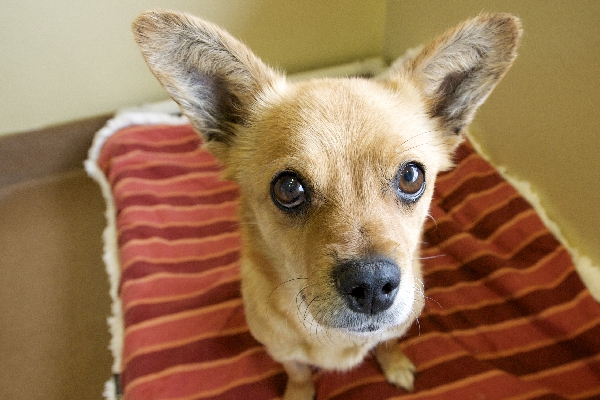Shelter dogs come from a variety of backgrounds.
Your dog may not know that it’s not appropriate to soil in the house. It is your job to teach him. Regardless of age and background, housetraining is attainable for all dogs. Proper training requires time, patience and consistency. And while some dogs will pick it up easily, others may take more time.
Two main strategies exist for housetraining:
- Crate Training is often the best choice. While learning not to soil in the house, your dog also learns to accept the crate as a safe, secure area.
- Paper Training is appropriate for small dogs who will not have regular access to the outdoors. This is a great option if you live in a high-rise building.
Regardless of what strategy you use, take your dog to the designated area upon waking in the morning, frequently throughout the day and right before bedtime.
Puppies
Determining how often a puppy needs to eliminate is as simple as taking how many months old they are and adding one. So, a two-month-old puppy needs to eliminate every three hours around the clock. Your puppy will likely need to eliminate after he wakes up, eats, drinks and plays
Try to go to the same spot each time. Keep walks brief and encourage your dog to sniff. This is an important part of the canine elimination sequence. Praise him as soon as he begins to squat and as he eliminates. Do not play or take long walks with the dog until after he has eliminated outside. If you take him out and he doesn't go (and you know that he’s due), put him in his crate for 20 minutes and take him out again. This will help him learn to eliminate in the right spot and set him up for success.
Feeding Schedule
Instead of free feeding, feed your dog at set meal times. Most adult dogs do well with two meals a day. Puppies need more frequent meals. Ideally, you will give your dog access to food for 20 to 30 minutes at each meal. (If he doesn’t eat it all right away that is.) Then pick up the food, and wait another 20 to 30 minutes before walking him.
Signs to Watch For
Be sure to watch your dog’s body language. Pacing, whining, circling, excessive sniffing or squatting are signs your dog may need to eliminate. If you catch your dog exhibiting any of these, interrupt the dog and immediately take him outside. If he eliminates outside, praise him and give him a treat.
Accidents - After the Fact
Never discipline or punish the pooch if you find an accident after the fact. He will not understand why he is being scolded. Instead, he will associate the punishment with you and the puddle of urine—not with the act of urinating in the house. This may seem like the same thing to you, but for your dog there is a huge difference between the act of urinating and the puddle.
Since your dog does not understand that it was their act of urinating that caused the punishment, in the future he may cower or act guilty when you come home to find another puddle or urine on the floor. Your dog’s guilty behavior is merely canine submission. It is his way of telling you he acknowledges your anger, but does not understand its cause.
Accidents - Caught in the Act
If—and only if—you catch your dog eliminating in the house should you correct him. The correction must take place at the same time as the undesirable action (preferably as the act begins).
The best correction is to verbally interrupt the behavior or use a loud noise such as clapping your hands. After interrupting the behavior, immediately take him outside (or to the designated soil area) to eliminate. Praise him when he goes outside.
Accident Cleanup
If your dog has an accident (and most will have at least one), getting rid of the underlying odor is crucial. Dogs use scent cues when deciding where to eliminate and the average dog has more than 300 million scent receptors.
Even if you cannot smell that spot on the rug, chances are that your dog can. Clean any soiled areas with mild soap and an odor eliminator. Do not use an ammonia-based product, which may smell too much like urine.
Always place your dog in another room before cleaning up mess. You do not want this to become a game.
Difficulty Housetraining
If your dog continues to eliminate inside after repeated attempts to house train or if your housetrained dog begins to eliminate inside, he may have a medical problem or behavioral problem that needs to be addressed.
First, have your dog thoroughly examined by your veterinarian (including urinalysis and fecal exam) to rule out any medical problems. If your dog is healthy and the problem persists, ask your veterinarian to refer you to a qualified animal behavior specialist.
Alternative to Crate
Paper Training
An alternative to crate training is to confine your dog to one dog-proofed area of the house when left unsupervised. You can use a baby gate to create this area and can gradually expand his access to the rest of the house.

